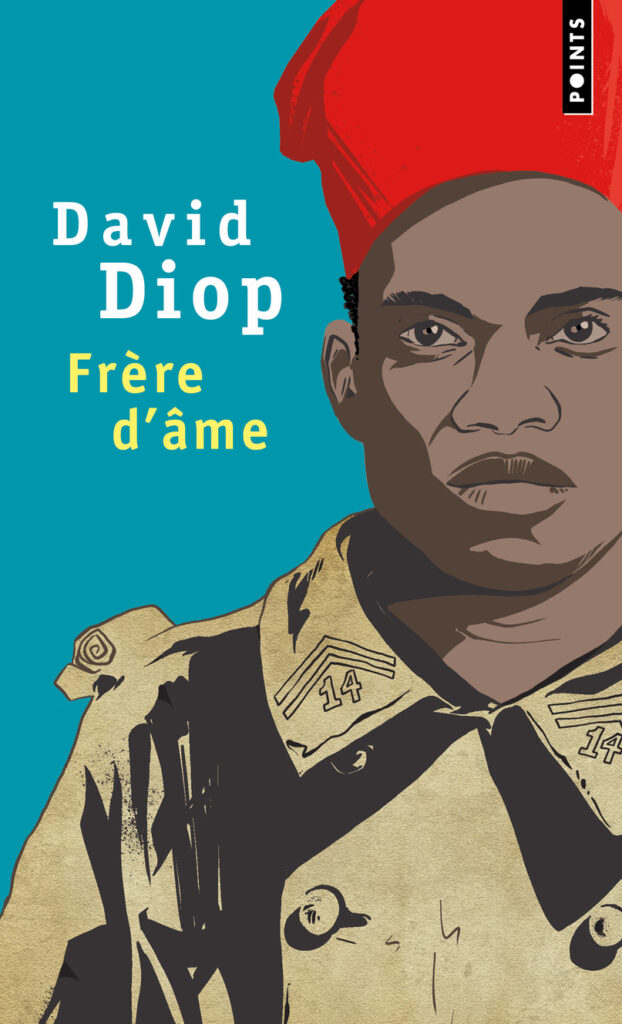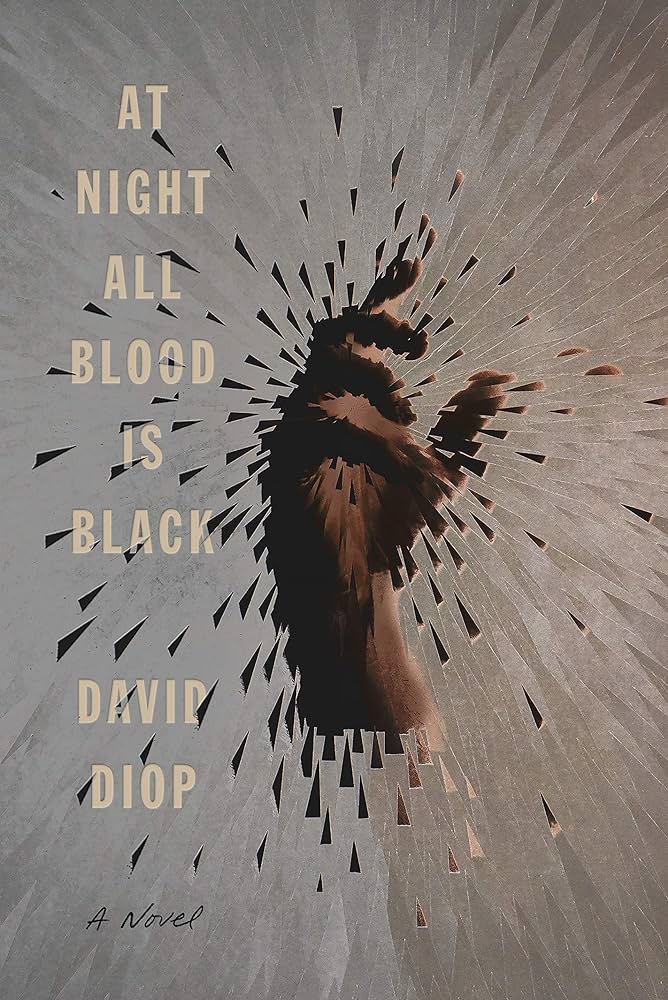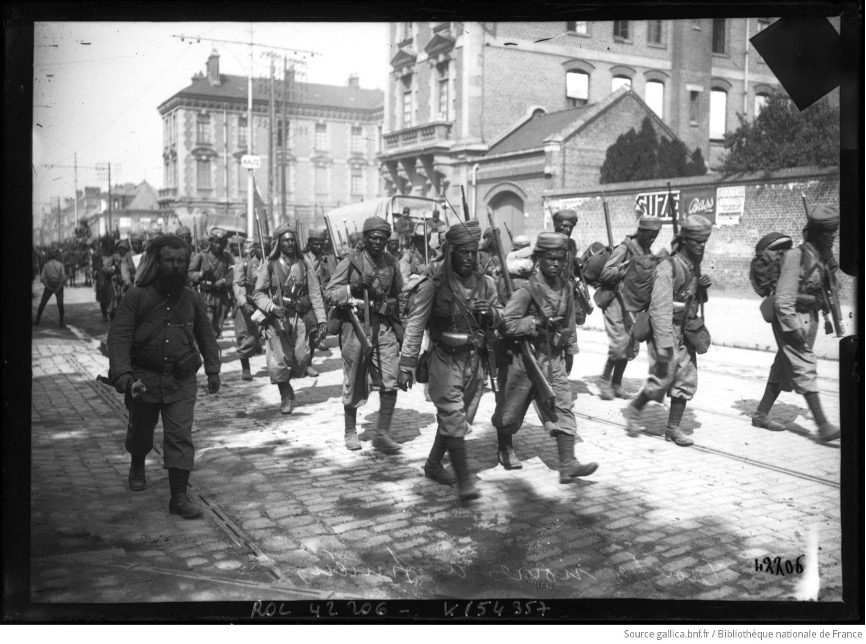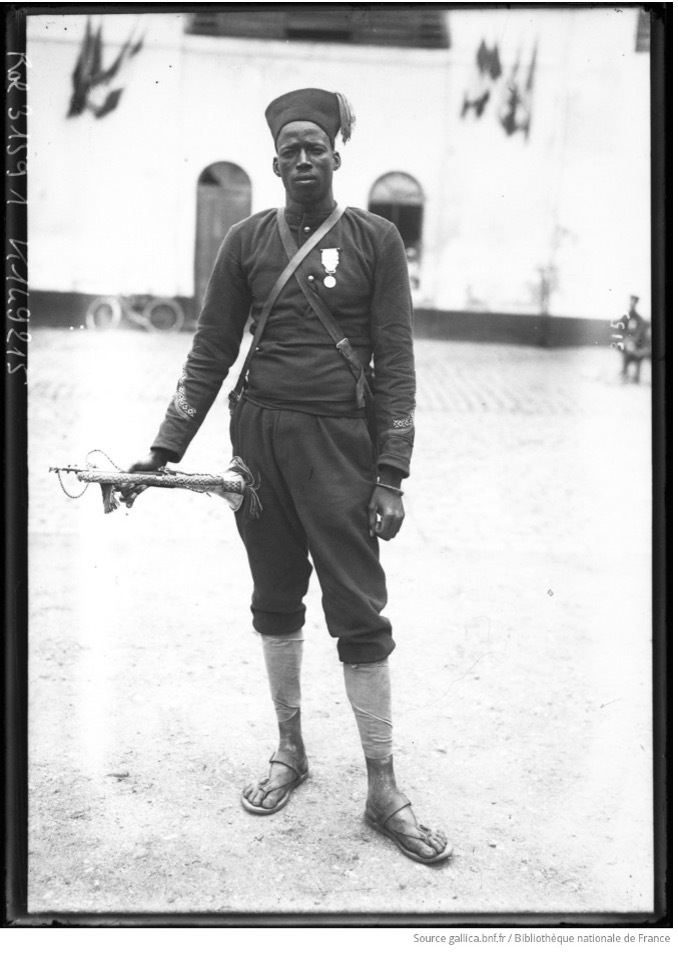Richard S. Fogarty, University at Albany, SUNY


The first thing a reader should do upon finishing David Diop’s Frère d’âme is to return to the first page and begin reading again. The ending brings us back to the beginning, and the opening sentence begins with an ellipsis—we enter into the story midstream, in the midst of the protagonist’s interior monologue, repetitive and incantatory in the tradition of oral storytelling, a style suited to tales of mythic dimensions. As he looks back over the events which have led him to the ending-as-beginning that readers will encounter twenty-five chapters later, Alfa Ndiaye begins to tell, or resumes telling a circular story of monstrous births and rebirths, a timeless story of war and filial bonds, two forces that tie human beings inextricably to each other as they descend into hellscapes shaped by violence and chaos, pride and rivalry, brotherhood and murder. And the first thing Alfa tells us is that “he shouldn’t have done it.” He should not have refused to kill his “more-than-brother” Mademba Diop, he should not have listened to the conventional strictures against fratricide inculcated by parents and ancestors and culture. As he moves in the space of a few pages from what he should not have done to what he should have done, Alfa tells us that he should have been humane and honest, a good friend and brother. He should have finished the job the Germans had started. He should have killed his brother and set him free.
Diop’s work has attracted well-deserved attention since its publication in France in 2018.1 Shortlisted for several prestigious French literary prizes, including the Prix Goncourt, the novel in English translation won the International Booker Prize in 2021.2 Diop was inspired by the tragic stories of men fighting and suffering in the First World War, often told in their letters and journals, but frustrated that such stories of the numerous West Africans who fought on the Western Front, often illiterate and in any case more reliant on oral traditions, were largely inaccessible.3 Raised in France and Senegal (he was born to a French mother and a Senegalese father), Diop set about filling this lacuna with a haunting tale of graphic violence and madness that seeks to recapture and relay experiences of war as they reverberate inside the psyche of a single African soldier in the French army.
When serving in French uniform, these infantrymen were known as tirailleurs sénégalais. This was true not only for soldiers recruited in Senegal, but also those from the large federation known then as French West Africa (Afrique Occidentale Française, or AOF). Over 160,000 of these men entered the French army between 1914 and 1918, joining over 30,000 West Africans already in uniform at the outbreak of war. 134,000 tirailleurs sénégalais served on the Western Front. Among all French colonial subjects who served in Europe during the Great War—more than 350,000 soldiers from North Africa, Madagascar, and Indochina joined the tirailleurs sénégalais in France—West Africans were particularly valued as “shock troops” because of their alleged primitive savagery.

Considered ideal for offensive operations and rapid frontal assaults, men of this “martial race” (race guerrière) became infamous among French and German soldiers and civilians for their supposed cruelty, for instance cutting off enemies’ heads, ears, or other body parts with fearsome machetes once used for clearing brush in West Africa but repurposed as trench-clearing weapons. West African soldiers’ reputation was based in rumor, fear, and gross racial and racist stereotyping, but was a critical component of the war culture of 1914-1918.4 It is just as critical to the story that David Diop tells in Frère d’âme.

When Alfa’s half-brother Mademba (possessed of the same father but born to different wives in a polygamous family) stops during an attack to inspect an apparently dead enemy, the German opens his eyes and uses his bayonet to slash Mademba’s stomach wide open. Lying mortally wounded in no-man’s land, with “his guts in the air, his insides outside,” (4) Mademba begs Alfa to kill him, to end his agony and suffering, to restore some dignity in the face of this atrocious pain and ignominious death. Lacking the courage to affirm his love for his brother in this way, Alfa refuses the request three times, just as Peter thrice denied his love for and kinship with Christ. It is only with Mademba’s death at dusk that Alfa repents of his decision not to “cut the barbed wire of his suffering,” (5) an inversion of Peter’s repentance after the cock crows at dawn on the day of Jesus’ crucifixion. Like Peter, Alfa sins against his brother out of cowardice and an excessive respect for “human law.” (5) His method of repentance becomes another inversion, plausible only in the inside-out madness of war’s unspeakable carnage.
Inversion and the war’s propensity to expose through violence what is normally hidden is a thread that runs through the novel. Trenches are “gaping wounds in the earth,” (4) or “like the slightly parted lips of an immense woman’s sex,” (9) which gives birth to Alfa when he attacks. (15) Everywhere on the battlefield, the “insides of the earth were outside,” (10) as men and weapons of enormous destructive power pulverize the landscape. And, of course, men and their weapons lay waste to bodies as well. The gaping wound that exposes the interior of Mademba’s body, his viscera exposed to the caustic air of battle and the horrified gaze of his more-than-brother, only accentuates the atrocious violation of the natural order that war engenders.
Wracked with guilt and remorse and feelings of failure and inadequacy, Alfa surrenders to the madness that war begets, even necessitates, and embraces the savagery expected of the men his captain calls, “Chocolates of black Africa.” (14) After French attacks across no-man’s land, Alfa remains hidden near German lines until the enemy soldiers relax. Then he pounces on one silently, incapacitating him by slashing the back of his knees with a machete, tying him up, and gagging him. Alfa then unbuttons the soldier’s jacket and shirt, exposing his belly, watching the terror in the German’s blue eyes, terror at what this black devil of whom he has heard so much might do (fears of rape and cannibalism added to that of simple, if terrible, violence): “I see in his eyes what he’s been told about me, and what he’s believed without ever seeing me.” (19) The German screams silently into the gag as he watches Alfa “take all the insides of his belly and put them outside in the rain, in the wind, in the snow, or in the bright moonlight.” (21) Finally, if the German still lives, Alfa slits his throat, “cleanly, humanely.” (21) To expiate his own sin, Alfa punishes his enemies for the violence they inflicted upon Mademba and shows them the mercy he withheld from his more-than-brother, killing his foes before the barbed wire of their suffering has fully played out in a lingering, agonized death without dignity or honor. “What I didn’t do for my friend, I do for my enemy. Out of humanity.” (20)
Alfa’s revenge is an attempt to repent via what are, at least in his mind, commensurate and analogous actions. But of course only a mind plunged into madness by war could find commensurability and analogy in what he does. The madness of racism and colonialism is also implicated, for Alfa does not stop with disemboweling and killing. He takes trophies from the corpses, and this is where the trouble with his comrades begins. Just as “the insides of the earth were outside,” and the insides of men were pulled outside by horrific wounds, Alfa’s mind is turned inside-out. In many ways, he finds this liberating, or tells himself that this is so, but he also knows that “I could think anything I wanted to, on the condition that the others knew nothing of it.” (10) And yet, even if his fellow French soldiers do not know the details of his ritual torture and killing of Germans in no-man’s land, he fails to keep fully secret his nocturnal hunts because he returns each time with the severed right hand of his victim.
Alfa inhabits the role that his officers and many others in France, Germany, and beyond fashioned for him and other West Africans, not merely the “bravest of the brave,” but “savage.” (14) The difference is that Alfa “became savage intentionally,” (15) and his savagery is not the temporary rage militaire that makes for great exploits on the battlefield. He brings his ferocity back to his trench, his thirst for blood inconveniently consistent, disturbingly persistent. The first three times Alfa returns with an enemy hand, he is a hero to comrades and commanders. He is “performing…the grotesque savage, the enlisted savage obeying orders.” (32) After all, “temporary madness, in war, is bravery’s sister.” (34) But after the fourth hand, he becomes instead “the true friend of death, its accomplice, its more-than-brother,” (34) no longer the madman his comrades are glad to have on their side against the Germans but the fearsome and inscrutable, unstable and unpredictable madman in their midst.
When he brings back a seventh hand, Alfa’s actions elicit a different response from his comrades. His fellow Africans fear him as a devil, a devourer of flesh and souls. His white French commander makes clear that “rage and fury cannot be brought back to the trench.” (47) Alfa must be sent away from the front for “rest.” Alfa understands that he has violated a tacit agreement, perpetrated an unspeakable and insupportable inversion of the tenet that the madness provoked by war, required by war, be fleeting and confined to moments of action on the battlefield. Because, in fact, this madness called courage is born of fear, and that inhuman fear must be left out in no-man’s land, with the slaughter and the blood and the dismembered bodies. “The severed hands,” he realizes, “are our fear, brought inside from outside the trench.” (48)
The taking of trophies from defeated enemies on the battlefield—from weapons, to armor, to body parts—is a practice as old as war, found in many cultures from prehistory to the present.5 But white European sensibilities in the nineteenth and twentieth centuries found the practice too redolent of a primitive, savage past that their advanced civilization had, they were sure, banished—even as they fashioned ever more destructive weapons that made possible appalling slaughter on scales unparalleled in human history.6 Many Europeans believed, though, that the practice of glorying in the defeat of one’s enemy by removing, keeping, and displaying parts of his anatomy was the sort of atavistic behavior that one could find readily among “lesser” races.
A certain symmetry attended the international scandal over atrocities committed in the Congo under the colonial rule of King Leopold II of Belgium, as agents of Leopold’s rapacious concessionary companies cut off the hands of Africans when they proved too slow or unwilling to collect ivory or rubber under dangerous, grossly exploitative circumstances.7 Of course, the thinking went, that is the sort of thing that happens in darkest Africa, among savage Blacks. That it was often indigenous agents of the concessionaries who amputated hands only reinforced the racist logic: Africans are prone to do that sort of thing, and European colonialism, with its supposed gift of its civilization to Africans, would stamp out precisely that sort of behavior. Such savagery was the failure of the European civilizing mission, a scandalous but ever-present danger in such a land and among such a people. In Heart of Darkness, Joseph Conrad’s mad ivory agent in the Congo, Kurtz, embodies the fragility of this mission, and one of the most telling and shocking symbols of his descent into corruption and insanity is his display of natives’ severed heads in his compound.8
This historical context shapes white Europeans’ reactions to Alfa Ndiaye’s collection of severed hands in Frère d’âme. His commander sends him to an asylum for “rest,” really for the treatment of psychic wounds that physicians were coming to call “shell shock.”9 Rest and care are not enough, however, and he cannot truly escape the “fury…vengeance…the madness of war.” (124) His suffering continues until he undergoes what appears to be a sort of psychotic break, leading to a collapse of his personality and an unspeakable crime. The war and its paroxysms of violence ultimately produce a shell of a man, raving mad dreams of power and violence, death and rebirth before a military tribunal.
Anna Moschovakis’s translation of David Diop’s lucid French prose into English does a wonderful job preserving the work’s powerful atmospherics. But one critical aspect of Diop’s language is necessarily lost in English. In French, “frère d’âme,” or “soulmate,” evocatively captures the relationship between Alfa and Mademba.10 Moreover, “frère d’âme” can evoke the context of war and its bonds of comradeship through its closeness to the term “frère d’armes” (brother in arms)—between the first and second there is only one letter’s difference and aurally, in French, there is only a small difference in the sound of each term. Alfa speaks of his “frères d’armes” on the very first page of the book, long before the term “frère d’âme” appears. A related and equally apt term that would surely occur to French readers considering the various forms of filial kinship invoked in the novel is frère de sang, or blood brother. All of this is lost in the English version, which takes its title from Alfa’s observation after he kills his first German victim, “At night, all blood is black.” (21)
Speaking about another act of translation—that of having his words translated from his native tongue into a French that his officers will understand—Alfa notes, “To translate is one of the only human activities in which one is required to lie about the details to convey the truth at large.” (138) Writer Tim O’Brien has asserted that translating the reality of war into stories that readers can understand is similarly fraught, an exercise that often calls for imagination and fabrication rather than strict fidelity to the literal truth.11 David Diop’s work is imaginative fiction, to be sure, attending to the surreal to try to capture the real, lived experience of men whose voices have left few traces, charting their interior lives under the extraordinary circumstances of war. But it is also remarkable how much of this novel’s details accord with what historians have uncovered about the experiences of Africans who fought for France during the Great War. Africans did fight under white French officers who all too often sent them into frontal assaults under the racialist assumption that this was the best use of their “primitive savagery” (General Charles Mangin, mentioned in the novel, is a famous example). German soldiers did fear Black Africans, perhaps above all other foes, because of racialist assumptions about their savagery. At the same time, some Africans did find comradery in the trenches with white French soldiers, as Alfa does with the doomed Jean-Baptiste—though, tellingly, he is Alfa’s “only real white friend in the trench.” (52) And some Africans did join the French army willingly, drawn like Alfa and Mademba by the allure of the uniform and the promise of improved social status as veterans.
This is not to say, of course, that the story Diop tells is a “true” story. But its imaginative, epic retelling of how it might have felt for a single, troubled West African to experience war and madness on the Western Front may very well be a “true” war story, as Tim O’Brien insisted such stories must be if they are to capture some of the hard-to-believe truths of war. “If at the end of a war story you feel uplifted, or if you feel that some small bit of rectitude has been salvaged from the larger waste, then you have been made the victim of a very old and terrible lie,” O’Brien writes. There is certainly no uplift or rectitude at the end of Alfa’s tale.12 Another of O’Brien’s assertions is particularly fitting for a story built on bellies and births and disembowelment: “It comes down to gut instinct. A true war story, if truly told, makes the stomach believe.”13 In the end, Alfa’s truth and the truth of his tale is “God’s truth,” a formulation he uses repeatedly: “now I was in the war alone.” (36) And that loneliness may be one of war’s most important truths.
Notes
- David Diop, Frère d’âme (Paris : Seuil, 2018). ↩︎
- David Diop, At Night All Blood Is Black (New York: Picador, 2021). Unless otherwise noted, all quotations in this essay are drawn from the English translation by Anna Moschovakis. ↩︎
- Anna Branach-Kallas, “Tirailleurs Sénégalais, Savagery, and War Trauma in At Night All Blood is Black by David Diop,” Journal of War & Culture Studies, 16: no. 1 (2023): 41-56. ↩︎
- For the history of West Africans in the Great War, see Marc Michel, L’Appel à l’Afrique: Contributions et réactions à l’effort de guerre en AOF, 1914-1919 (Paris: Publications de la Sorbonne, 1982); Myron Echenberg, Colonial Conscripts: The Tirailleurs Sénégalais in French West Africa, 1857-1960 (Portsmouth: Heinemann, 1991); Joe Lunn, Memoirs of the Maelstrom: A Senegalese Oral History of the First World War (Portsmouth: Heinemann, 1999); Gregory Mann, Native Sons: West African Veterans and France in the Twentieth Century (Durham: Duke University Press, 2006); Richard S. Fogarty, Race and War in France: Colonial Subjects in the French Army, 1914-1918 (Baltimore: Johns Hopkins University Press, 2008). ↩︎
- Lawrence H. Keely, War Before Civilization: The Myth of the Peaceful Savage (New York: Oxford University Press, 1997). ↩︎
- Daniel Pick, War Machine: The Rationalisation of Slaughter in the Modern Age (New Have: Yale University Press, 1996). ↩︎
- Adam Hochschild, King Leopold’s Ghost: A Story of Greed, Terror, and Heroism in Colonial Africa (New York: Houghton Mifflin, 1998). ↩︎
- Joseph Conrad, Heart of Darkness (New York: Penguin, 2022). ↩︎
- John E. Talbott, “Soldiers, Psychiatrists, and Combat Trauma,” Journal of Interdisciplinary History, XXVII, no. 3 (Winter, 1997): 437-454; Jay Winter, “Shell Shock,” in Jay Winter, ed., The Cambridge History of the First World War, Vol. III (Cambridge: Cambridge University Press, 2014): 310-333. ↩︎
- Some have rendered this term as “soul brother” when writing about Diop’s book, but this very American term resonates with the US racial landscape and history in ways that fail to convey the distinctiveness of the French context, certainly during the early twentieth century. ↩︎
- Tim O’Brien, “How to Tell a True War Story,” in The Things They Carried (New York: Penguin, 1990), 73-91. ↩︎
- O’Brien, 76. The statement (probably intentionally) resonates with echoes of the Great War and Wilfred Owen’s famous poem, “Dulce et Decorum Est,” which calls the title words (from Horace’s, “It is a sweet and fitting thing to die for one’s country”), “The old lie.” ↩︎
- Ibid., 84. ↩︎
